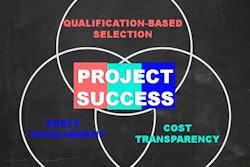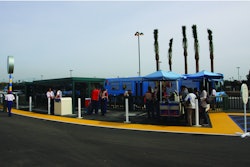Fred Perpall was named managing director of the eastern division of The Beck Group in November. The promotion signals his championing of an "integrated enterprise structure" that is a growing strategy for the Dallas-based commercial real estate builder.
This integrated structure puts architects alongside construction managers for the entirety of a project. Beck contends this approach cuts inefficiency and waste caused by miscommunication and conflicts that arise in the traditional architect vs. builder model of commercial construction. The company says its integrated model reduces clients' risk and saves them money.
Beck began using this integrated model in its eastern division -- its territory east of the Mississippi River -- in 2004. Next year, Perpall estimates, 80 percent of the eastern division's business will be integrated and will account for roughly $50 million in annual revenue.
Q: How does your integrated enterprise structure drive down risk?
A: Let's say you are the customer, and I am an architect interpreting your vision, and we create a great vision document. Then we turn over that document to the builder. Any gap in communication, any gap in scope, any gap in intention -- if there is something that is miscommunicated, there's usually a gap, and the owner has to pay for that gap. We have nice words for that gap: change orders and contingencies. But these are real wastes, and our average customer tells us that gap represents 4 to 8 percent of the cost of the entire project. In our process, there is no gap... We carry that risk.
Q: How does that affect overall costs? Does that mean you shave that 4 percent to 8 percent off your bid for a project?
A: Most of our customers, because they are building buildings all the time, are driving more for lower final cost vs. lower initial costs... Having the services bundled doesn't give you a combined services discount upfront. Most of our customers understand that we don't want to be the lowest-cost provider, we offer less risk and a more value-driven process.
Q: Does that mean that the price you quote stays about the same through the entire project?
A: Absolutely. In fact, we guarantee that the price does not change unless they [the customer] change something in their scope.
Q: How can you make your business model work if you are taking on this much risk?
A: Risk to us equals control. We are willing to take on risk for things we have control over. So, a customer in this model is allowing us to take more control over the design... over how we manage purchasing for the building, over how we manage our commodities and labor cycles.
Q: Did you get pushback from your subcontractors, who often make good money on contingencies and change orders?
A: Subcontractors have a different profile of risk. For them, clarity equals confidence... The subcontractors love this method if we can be very clear and very intentional with them early on. It allows them to buy in a more confident way. It allows them to lock into prices with their labor. This is part of our strategy, by the way. Over time, we want our subcontractors to perform so well in this business setup that they always give us a more competitive price. We want that to be a competitive advantage for us.
Q: Has that happened over the past few years?
A: Yes, we do try to stay within the same circle of subs... We know where the best chemistry is [with subcontractors].
Q: What are the challenges with this collaborative system? Why doesn't everyone do it this way?
A: The first challenge is people... We want people who have vertical depth in terms of their knowledge and their skill set. Then we want them to also be broad in their interests -- not necessarily in their knowledge. You don't have to be the best estimator as an architect, but you need to be empathetic toward what that estimator's job is. You need to understand it well enough to understand how your role supports his role... These people you don't hire off the street. You have to develop them. Another challenge is the status quo. We have customers who have built entire organizations around status quo delivery. They have people in place to manage these conflicts [between architects and builders].
Q: So the clients have built around the dysfunction in your industry?
A: Absolutely. They've built entire businesses around this dysfunction. So, you have to present this [collaborative method] in a way that is nonthreatening to the very people who have to hire you.
Q: Are there other challenges?
A: It also has been a challenge in terms of our colleagues. For example, if you are going after the construction of something as a builder, and you are collaborating with an architect, that architect may feel somewhat threatened if you also have an architecture arm. That is one reason we are increasingly trying to work for end users [building owners], not intermediaries.
Q: Who are your typical customers?
A: The customers who typically hire us are the people who build the most -- the federal government, universities, hospitals -- people who understand that building this building is going to be a risky process. They've done it enough. They've been burned enough to know that it is better to have a much more collaborative team that can take on that 4 to 8 percent gap.




















